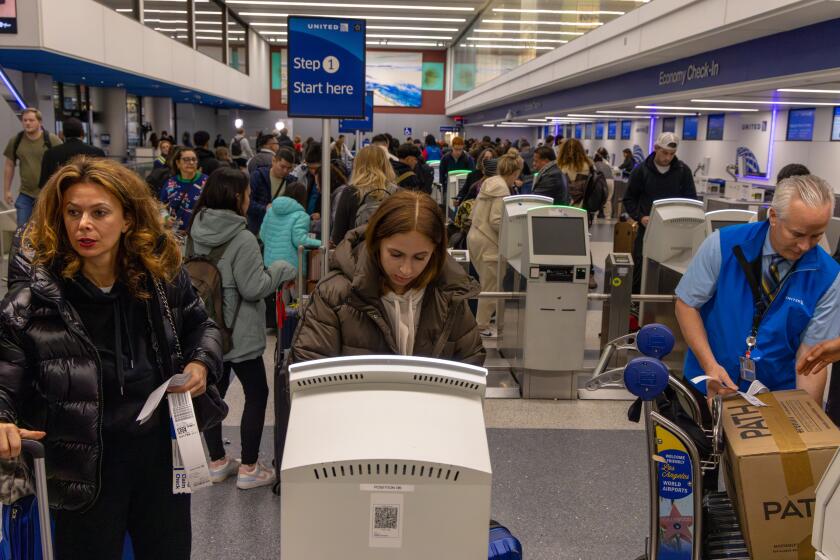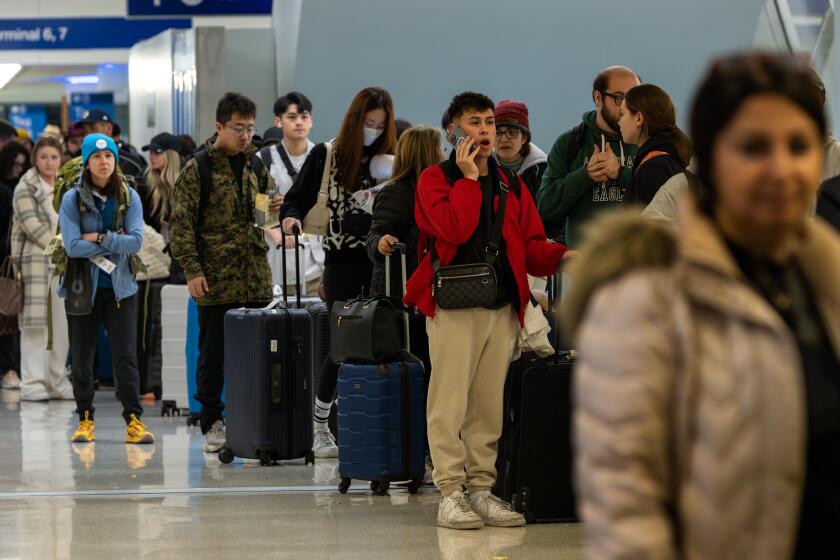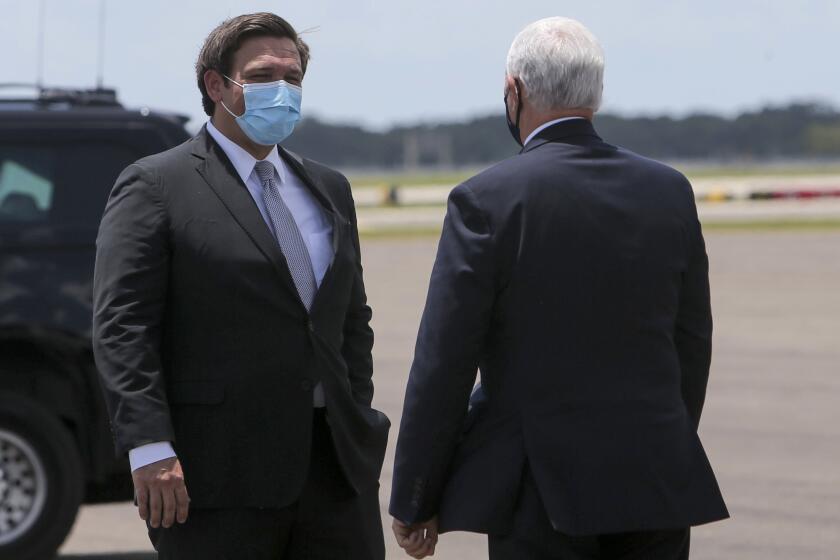COVID-19 intensifies across California, with the worst probably still to come

- Share via
The winter COVID-and-flu season is ramping up in California and nationwide, with doctors and other experts saying the worst of the respiratory illness season is still to come.
New data show pronounced recent jumps in the rate at which coronavirus and flu tests are coming back positive, as well as the number of hospital-admitted patients testing positive for the viruses. Workplaces are also seeing higher numbers of employees call in sick due to infections.
National wastewater data suggest this winter could see the highest number of coronavirus infections occurring during any given week since the first Omicron wave began in fall 2021.
“And we’re probably not quite to the zenith of it yet,” said Dr. Elizabeth Hudson, regional chief of infectious diseases at Kaiser Permanente Southern California. “Looking at some of the data that we can extrapolate out from the wastewater, by the time we get to about Jan. 10 or so, we’re probably going to be seeing, within the U.S., about 2 million cases a day.”
California’s hospitals are getting busier with more COVID-19 and flu patients. Los Angeles County recently entering the ‘medium’ COVID-19 category for the first time this winter.
The good news is the number of people becoming seriously ill remains lower than last year, when hospitals were deluged by a “tripledemic” of COVID, flu and respiratory syncytial virus, or RSV.
The peak of the 2021–22 Omicron wave crested at about 5 million cases a day, Hudson said.
This winter, by contrast, there are far fewer critically ill COVID-19 patients requiring intensive hospital care, even though plenty of people are sick.
Flu is also making its presence felt in a major way.
“There’s just this dramatic rise in influenza,” said Dr. Caroline Goldzweig, chief medical officer of the Cedars-Sinai Medical Network.
In terms of the demand for outpatient care, “We’re definitely seeing a huge amount,” said Dr. Chris Hiromura, associate program director for the family medicine residency at Adventist Health White Memorial hospital in Boyle Heights.
There’s “definitely a huge spike in the outpatient COVID numbers, and just general viral illnesses,” he said, as well as a more modest uptick in respiratory illnesses severe enough to require hospitalization.
Coronavirus transmission is once again spiking in California entering the winter holiday season — and the new JN.1 subvariant may be partly to blame.
The rates at which tests for the coronavirus and flu are coming back positive have been rising over the last month in Los Angeles County. For the week that ended Dec. 30, 18% of tests at county surveillance labs were coming back positive for flu, up from 10% a month earlier. As for the coronavirus, 13.5% were coming back positive, up from 9.9% a month earlier.
“Our emergency department is very busy, as well as our inpatient units,” said Dr. Graham Tse, chief medical officer for MemorialCare Miller Children’s & Women’s Hospital Long Beach. “It’s a mixture of the three viruses — influenza, COVID and RSV — but there’s also many other respiratory viruses that we’re also seeing that are always more prevalent during the winter.”
Nationally, there were 34,798 new coronavirus-positive hospital admissions for the week that ended Dec. 30, a 20% jump over the prior week and the highest one-week total in nearly a year. Last winter peaked at 44,542 new hospital admissions for the week that ended Dec. 31, 2022.
California recorded 3,516 new coronavirus-positive hospital admissions for the week that ended Dec. 30, a 7% increase from the previous week, according to the U.S. Centers for Disease Control and Prevention. The state’s peak last winter was 5,260 new hospital admissions for the final week of 2022.
Since Oct. 1, the CDC has reported an average of about 1,400 COVID-19 deaths a week nationally. Over the same time period last year, there were about 2,400 weekly COVID-19 deaths.
COVID-19, flu and respiratory syncytial virus (RSV) cases are all on the rise or at a high level in California and elsewhere.
Seven California counties Friday joined the CDC’s “medium” level of coronavirus-positive hospitalizations from the “low” level: Orange County; Alameda and Contra Costa counties in the San Francisco Bay Area; and in the Central Valley and Sierra, Stanislaus, Merced, Tuolumne and Mariposa counties. Los Angeles County and the four-county Sacramento area were already in the medium level.
A more contagious subvariant may be aiding the spread of COVID-19. Nationally, the subvariant JN.1 was estimated to account for 62% of coronavirus specimens for the two-week period that ended Saturday; it accounted for 39% of specimens for the prior comparable period.
Last winter’s viral tripledemic taxed hospitals, with the burden of RSV weighing particularly heavily on pediatric facilities. Though there are a lot of cases of RSV this winter, Hudson said, “it’s not quite as severe as it was last winter.”
In general, “what’s different this year is this really does seem to be something that is impacting adults a lot more — particularly those who are over the age of 65,” Hudson said.
Even if someone’s bout with COVID is relatively mild, it poses a risk of exacerbating underlying health problems. For instance, a person with a lung disease such as emphysema who comes down with COVID-19 may need hospitalization to get additional oxygen, Hudson said.
Flu is also putting many patients out of commission.
“We are definitely seeing a pretty big uptick in flu ... mostly on the outpatient side,” Hudson said. “But, you know, flu is pretty miserable. If you’ve never had it, I always describe it as being hit by a Mack truck, because it’s the only way that you can really understand how crummy you can actually feel with it.”
Flu has also forced concert cancellations in recent months, waylaying performances by Christina Aguilera and the rock band KISS.
The San Francisco Bay Area fared better during the COVID-19 pandemic than many other populated areas thanks in part to early stay-at-home orders, mask mandates and high uptake of vaccines, experts suggest.
One complication Hudson has noticed in recent months is that people might have COVID-19, but it’s taking longer for rapid tests to return a positive result. It used to be that someone might test positive for the coronavirus one or two days after the onset of symptoms using a rapid test, Hudson said. Now, positive results might not show up until perhaps the fourth day after symptoms start.
People who initially test negative for COVID-19 despite having symptoms and don’t retest later “could be getting a false sense of security” that they don’t have COVID when they actually do, and are contagious, Hudson said.
The delay in accurate test results is probably a result of people having accumulated immunity from COVID-19 over the years, whether from vaccination or previous infection, that is prolonging the testing window, according to Hudson.
Ron DeSantis cited a scientific journal as evidence Florida had a lower COVID death rate than California. The study’s author says that’s not the whole story.
It’s important that people take steps to limit their risk of getting or developing severe complications from COVID-19, flu or other viral illnesses, doctors say. Those include getting a fresh COVID-19 and flu vaccine this winter, which many people have not yet done. For babies, pregnant people and older adults, an RSV immunization is also available.
“People who are diligent and get the updated vaccinations as they come out, they’re just going to be less likely to have severe disease,” Goldzweig said.
It’s important to realize that COVID-19, despite being less deadly than the pandemic’s more harrowing phases, is no mere common cold virus.
“We still see people getting long COVID — even if they’ve had COVID before, even if they’ve been vaccinated,” Goldzweig said.
Even people who are younger face “about a 20% increased risk of heart attacks and stroke” within six months of a COVID illness, “which for people who are in their 30s and 40s is a pretty big increase,” Hudson added. So although for some COVID infections might feel like a regular cold, “it can potentially have longer-lasting impacts that we’re only really starting to understand.”
“It’s not about living in fear. It’s just about understanding that there are more risks to this than just a run-of-the-mill sore throat,” Hudson said.
Data increasingly suggest getting vaccinated reduces long COVID risk, a factor officials have cited in recommending most everyone get a reformulated vaccine this year.
The latest wave also has continued to infect the diminishing number of people who had never had COVID-19 previously, including Dr. Eric Topol, director of the Scripps Research Translational Institute in La Jolla.
Topol, who got it last month, has remained careful about trying to avoid the coronavirus, but was infected after a colleague with whom he shares an office came down with COVID-19. That colleague was similarly cautious, so neither wore masks while sharing their office, Topol said. The colleague doesn’t know how he was infected.
“It’s picking off a lot of new hosts right now,” Topol said.
In an op-ed published in The Times, Topol wrote that the coronavirus, with its ongoing ability to accumulate mutations, has “proved to be highly resilient” and has not been “transformed to common cold status.”
To truly get back to normal will require new oral, inhaled vaccines that can “achieve high levels of mucosal immunity and protection against infections, which would be variant-proof,” Topol wrote. Also helpful would be “improved, variant-proof shots with better protection and durability.” He said these efforts are not getting the urgent priority they need to be completed this year.
“We’ve got to come up with a way to, as soon as possible, stop infections and transmission,” Topol said in an interview. “That’s what we’re missing now. That’s how we get to normal. That’s how we get variant-proof. And then we can rest and feel really good about it.”
More to Read
Sign up for Essential California
The most important California stories and recommendations in your inbox every morning.
You may occasionally receive promotional content from the Los Angeles Times.




















